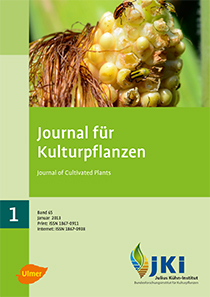Searching for biomarkers in the grape leaf metabolome
DOI:
https://doi.org/10.5073/JfK.2013.01.03Keywords:
Organic viticulture, non-targeted analysis, SPME-GC-MS, grapevine leaves, resistance biomarker, powdery and downy mildewAbstract
Powdery and downy mildew of grapevine are widespread diseases, which may cause severe harvest losses. In organic farming only copper containing fungicides are permitted. In relation to the longtime application of copper containing plant protection products the impact of copper deposit in soil and its effect to soil organisms are discussed nationally and internationally. Therefore, developing alternative plant protection strategies is an important field of research. Thus, the metabolite profiles of resistant grapevine species (American wild type species and old hybrid grapevine varieties) are compared during a triennial survey with representatives of the more susceptible European grapevine cultivars by non-targeted analysis assays. This might give some hints to so far unknown resistance biomarkers or elicitors. The different volatile organic compounds (VOCs) of the leaf metabolome were analyzed by headspace-SPME-GC-MS. In an annual survey 81 out of 120 volatiles detected in grapevine leaves were identified. Though many of the components are included in several individual species and varieties, there are detectable differences with respect to their quality and quantity. Multivariate statistical data processing (PCA) showed that both the leaf development stadium and the grapevine species (resp. variety) have a great impact on the volatile profile. In contrast, the distinctions in the metabolomes of different plants which belong to the same variety are less obvious.
Downloads
Published
Issue
Section
License
The content of the journal is licensed under the Creative Commons Attribution 4.0 License. Any user is free to share and adapt (remix, transform, build upon) the content as long as the original publication is attributed (authors, title, year, journal, issue, pages).
The copyright of the published work remains with the authors. The authors grant the Journal of Cultivated Plants, the Julius Kühn-Institut and the OpenAgrar repository the non-exclusive right to distribute and exploit the work.







